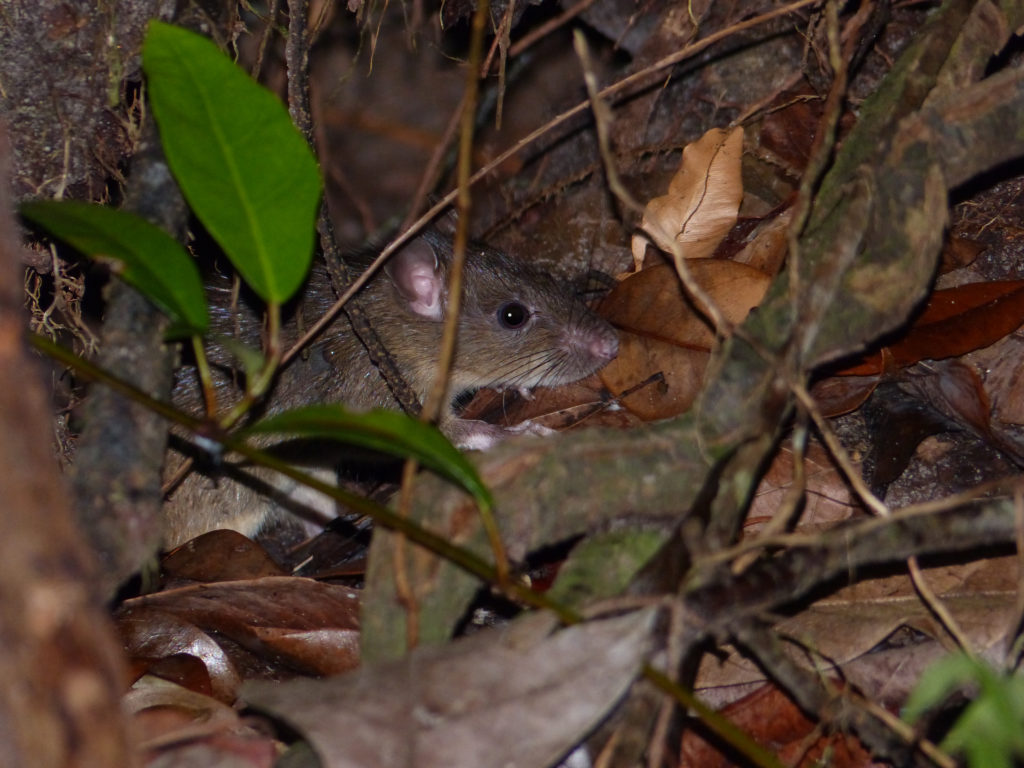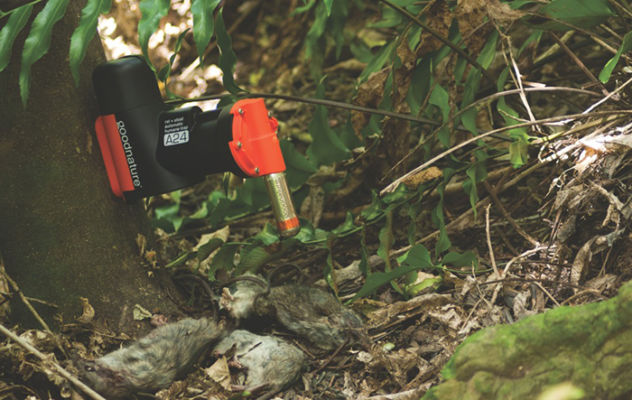Markus Gronwald and James Russell from the University of Auckland recently measured rat relative abundance on Goat Island, 70km north of Auckland.
Both camera traps and digital strike counters for Goodnature A24 self-resetting traps were used and the results compared. A total of 7155 videos, more than 119 hours of footage, from 2161 camera days were analysed. Seventy-four percent of the videos recorded rats.

“Goat Island (Te Hāwere-a-Maki) is a small island of approximately 9.3 hectares. It lies in the Cape Rodney-Okakari Point Marine Reserve in Leigh on the east coast 70 km north of Auckland. The island has small breeding colonies of seabirds: grey-faced petrels and little penguins. Ship rats are the only invasive mammal permanently present on the island. During low tide rocks are exposed along the coastline and reduce the distance between the mainland and the island to less than 100 m. This enables ship rats to swim across and imposes a risk of an incursion. Maintaining Goat Island rat-free has proven difficult and ship rats remain abundant.”
Reliable monitoring is needed for early detection of invaders, invasive species control and eradication programmes require reliable monitoring. Monitoring tools must be able to detect individuals at low population densities and species which are reluctant to interact with detection devices.
“In New Zealand, tracking tunnels are a widely used method for monitoring relative abundance of rodents and mustelids. Interaction is minimised to walking through the tunnel and the tunnels are perceived as the better alternative to snap traps. However, ship rats showed hesitation in stepping on the ink pads in a pen trial, a behavioural response that can potentially affect monitoring rats in low population density. Motion-activated trail cameras are alternative detection devices which can optimize detectability in low population density or of species or individuals with reluctance to interact with detection devices.”
Small, fast moving animals can be technically challenging for trail cameras, however. Ongoing technological improvement, including sensors, trigger speed, and resolution increases their suitability for surveys of small species and motion-activated game trail cameras extend the tool set for monitoring animal abundance in both scientific studies as well as conservation projects.
Economically there are both advantages and disadvantages to using trail cameras.
“An index of abundance is easier and cheaper to obtain than performing a capture-recapture study for robust population density estimates. However, cameras have high initial costs to purchase and the unautomated analysis of videos is labour intensive.”
The researchers evaluated two different methods for obtaining an index of abundance from camera footage for invasive rats based on 1) the number of videos showing rats per time unit, and 2) the number of rats in videos per time unit.
“Rat population density at the study site was unknown. The comparison of the two methods sets out to determine if the obtained indices of rat relative abundance differ and if the difference changes when rat numbers are reduced due to ongoing kill trapping. We then also evaluate the reliability of a digital strike counter for characterising killed individuals at Goodnature A24 CO2 powered self-resetting rat and stoat traps where carcasses do not necessarily remain at the trap and therefore cannot be counted. Finally, we compare indices of abundance from digital strike counters and camera traps to assess if camera traps are a suitable tool for monitoring rat abundance and trends in it.”
Ten A24s, each with a digital strike counter, were placed across the island in July 2016 at an average distance of 75 metres (range 45–89 m).

“The strike counter senses the vibration of the triggering of the trap and briefly displays the number on a digital LED display and records the number of times the trap fires. The traps were baited with Goodnature Automatic Lure Pumps (ALP)-chocolate formula for rats. During the 15-month field trial, from August 2016 to October 2017, the ALPs were replaced after 6 months in January and July 2017. Gas cartridges were replaced when the strike counter showed 20 or more. The traps were on average checked every 49 days (range 27–63 days).”
Each A24 was monitored with a trail camera with PIR motion-activated sensor to record rat activity around the devices.
“The detection rate when using cameras with PIR sensors is related to the body mass of the detected animal. Small and fast or very slow-moving animals might not be detected. Therefore, the highest sensor sensitivity was used for all cameras. Cameras were set to record a 60-second video when triggered with a one second interval between videos.”
Because the display of the digital strike counter blinks when the A24 is triggered, each trigger count is visible in the video. Only videos showing the moment when a rat triggers the A24 were analysed.
“Records were made if the rat was hit and/or if the strike counter was triggered to evaluate the reliability of the digital strike counts. Even though the ‘capture’ rate for predators are higher with cameras than kill traps, the strike counters have the potential to be a reliable and relatively cheap monitoring tool for Goodnature A24s.”
“Two different ways of counting can be used to determine an index of rat relative abundance from camera footage, either the number of rat videos (i.e. a video where one or more rat is present at any time) per 100 camera-days (video index) or the number of rats (i.e. the maximum number of rats observed at once in a video) per 100 camera-days (rat index). A video can show more than one rat. Determining the rat index is much more labour intensive than the video index. Therefore, an evaluation of the difference between the two indices will determine how much workload is needed for future video analyses.”
The good news is there were only minor differences in the index values between rat index (labour-intensive) and video index.
“The average number of rats per session that could be seen in a video with rats was 1.03 rats per video. Since usually only one rat was ever seen in a video, the video index is close enough to the rat index to be chosen as a measure of abundance without losing information but easier to obtain.”

“The moment of a rat triggering an A24 was visible and audible in 70 videos, in a further 24 videos the activation of the strike counter was missed due to delayed recording. In 60 videos the rat was obviously hit lethally. The strike counters recorded 92% of the kills correctly (i.e. were triggered when a rat was killed), slightly underestimating the actual number of kills confirmed by the video footage. In the remaining 10 videos where the rat was not obviously hit lethally, the strike counters still recorded the triggering 30% of the time, resulting in overestimated kill counts, although these cases were few. However, the overall counts correlated with the actual kill numbers well, as these two opposing errors of count tended to balance each other out. Ultimately, there was a slight underestimation from the strike counters with 97% of all kills being reflected in the strike counts, i.e. 58 strikes for 60 kills.”
“The video index was the highest in the first month after trap deployment and after three months it remained relatively constant for the rest of the study. The A24 index showed a similar pattern in the first three months but then fell to almost zero at the end of the study, 0.7 kills per 100 trapping days in October 2017. Unlike the A24 index, the number of rat videos stayed at a constant high level. There was no significant evidence of a correlation between the two indices.”
The study showed that a large amount of video analysis time can be saved while still getting reliable data using the video index method, but this might not apply if the rat population was very high and multiple rats were appearing in the footage at once.
“When measuring the abundance of rats on Goat Island the video index and the rat index differed only to a small margin. However, obtaining the rat index involved more work. The whole video had to be watched to count all possible rats and the identification of individuals costed extra time and would always contain an element of subjectivity. The time used for the analysis went beyond the actual footage time and increased the work nearly ten-fold. The difference between the indices could be larger when the population density is higher, i.e. many more than one rat seen per video.”
“Besides time saving, video categorising can be undertaken by any person who is capable of identifying a rat. This enables the involvement of non-professionals in the analysis of huge data sets in academic research (Citizen Science).”
While a kill by a single kill trap can be confirmed by the presence of a carcass or parts of it, the only consistent evidence at an A24 is the strike counter number, so the degree of accuracy of these counters is of interest.
“The numbers acquired from the digital strike counters were generally a suitable representation of the actual number of individuals killed. When a rat is killed by the self-resetting A24 its body drops to the ground. However, the rats can still move a few metres away from the trap and roll out of the field of view in spasms. In addition, rats, ruru and kāhu are potential scavengers and were present on or nearby Goat Island. The strike count numbers have shown to slightly underestimate but approximately match the real number of kills closely enough to be seen as a reliable source of information.”
“It should be noted that the strike counts can only be used to estimate relative abundance in areas with only one target species and when it is unlikely that non-target species can trigger the trap. A general advantage of the strike counters is that they provide information suggesting when the gas cartridge has to be replaced. In high population density of the target animals the traps might be triggered more than 24 times within 6 months, which is the maximum trigger number advised for the cartridges per manufacturer.”
At low rat abundance, differences between the monitoring by A24 counters and camera traps became apparent.
“The A24s failed to detect remaining individuals on Goat Island towards the end of this study. The camera traps revealed that the rat removal rate was too low to sufficiently reduce rat activity. Long term trials have shown a reduced kill rate for A24s when initially successful trapping reduced abundance to low levels. Therefore, camera traps were a valuable tool to gain information about rat abundance on Goat Island.”
So, in summary, what are the advantages and disadvantages of motion-activated cameras?
“Motion-activated cameras, as a non–invasive detection tool, circumvent the need for device interactions. At the moment, the most common method in New Zealand is the use of tracking tunnels with ink cards which require interaction between the individual and the tunnel. The animal has to enter the tunnel and can show reluctance in the first night. Cameras don’t intervene with the natural behaviour of the rats. The distance between detector and individual can be several metres, while animals may sense cameras through audible and visual cues, it does not necessarily influence the detection rate.”
“However, technological imperfections cause error. Camera specifications, e.g. different types of sensors or trigger speed, influence the detectability in a negative way. Standardising the field of view, sample size and trapping distance in a best practice protocol for the use of cameras in monitoring the abundance of invasive mammals is needed to enable the comparison of results across study sites and ecosystems.”
Digital strike counters are useful in some situations, but also have limitations.
“Digital strike counters were proven to be a reliable source of information for the number of individuals killed by A24s in our study, where ship rats were the only target species and interactions of non-target species with the traps were unlikely. However, the cameras were better than A24s in detecting rats once abundance was reduced after sustained trapping. The camera traps were a suitable tool for monitoring invasive rats at different abundances on Goat Island.”
The full research report is published in the New Zealand Journal of Ecology and is freely available online.

